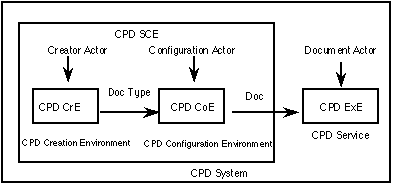

by Maria Manuela Marques
Currently, organisations still rely heavily on paper-based documents. These documents are instruments of administrative processes, representing their visible part. Since the processes, themselves, are most of the times not explicitly described, it is by means of the knowledge embedded in the documents and their flow through the organization, that the processes are implicitly known.
A system to support the cooperative processing of documents in an organisation is described below. The system allows to define each type of document flowing inside an organisation, in particular its processing path (processing chain), in terms of the structure of the organisation (units, competences) and the roles (actions) to be performed. This allows to define explicitly the organisational processes in question.
In order to allow an organisation to automate the processing of its documents, we have developed a system called CPD (Cooperative Processing of Documents). Each user edits its part of any given document and the system forwards it to the next one along the document path. In CPD, "Cooperative" means that several users cooperate by editing the various parts of each document, one at a time. The objective of the work is not to address simultaneous edition, but rather to create an environment that simplifies the installation of this system in different organisations, and automates the production of the run-time environment that implements the various processes involved.
For each existing type of paper-based document an electronic form is created (called a document type). After this definition phase, the run-time environment can be used to create and manipulate instances of the various document types (i.e., documents). The routing of each document and its processing through the organisation in question is called a CPD service. The part of the CPD system which is responsible for creating new CPD services is called the CPD Service Creation Environment (CPD SCE).
The CPD system architecture is presented in the figure. It is composed of two main modules: Service Creation Environment (CPD SCE) and Execution Environment (CPD ExE). The CPD SCE is composed of two parts: Creation Environment (CrE) and Configuration Environment (CoE).

The CPD Creation Environment offers the following set of facilities:
The CPD Configuration Environment assures the creation of the actual processing chain for each triggered document. It populates the nodes of the corresponding document type processing chain with actual individuals/units, according to the individual/unit triggering the document, and taking into consideration the information established in the organisational database.
The CPD Execution Environment allows the animation of the various processes by allowing the participation of end-users in document processing. An User-Agenda presents the user (individual/unit assigned to the processing chain node) with the various documents he is expected to process. These are presented in folders (In-folder for documents arrived since the last time the user has checked it and Processing-folder for documents not yet completely processed). Once the document has been processed the CPD ExE moves it to the In-folders of the next person in the processing chain.
The CPD system was one of the experiments of the SCORE project. The SCORE process model, and recommended methods and tools, were used and evaluated during the analysis and design of the CPD SCE. A CPD SCE prototype was developed using the SPECS/RACE 1046 CR&F methodological environment, with OMT/Paradigm Plus, SDL/Geode and C++. In order to speed up the development of the first service using this prototype, ORACLE V7 tools were used as a basic platform.
A main result is that the process model offered by the CPD SCE for creating CPD services corresponds to a simplified version of the SCORE process model. This is not due to a loss of functionality: several activities are automated, facilitating the creation of CPD services. For example, when the system is already installed in an organisation, and a new document type has to be introduced, it is enough to analyse the new service and to describe the new document type (the layout and the processing chain), using the above mentioned facilities of the CPD Creation Environment.